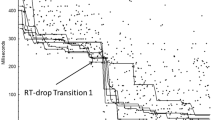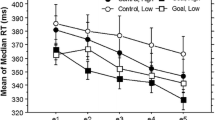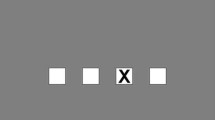Abstract
Serial reaction time tasks, in which subjects have to match a target to a cue, are used to explore whether non-human animals have multiple memory systems. Predictable sub-sequences embedded in the sequence of cues are responded to faster, demonstrating incidental learning, often considered implicit. Here, we used the serial implicit learning task (SILT) to determine whether rats’ memory shows similar effects. In SILT, subjects must nose-poke into a sequence of two lit apertures, S1 and S2. Some S1 are always followed by the same S2, creating predictable sequences (PS). Across groups, we varied the proportion of PS trials, from 10 to 80%, and show that rats with more PS experience do better on them than on unpredictable sequences, and better than rats with less experience. We then introduced test trials in which no S2 was cued. Rats with more PS experience did better on test trials. Finally, we reversed some sequences (from predictable to unpredictable and vice versa) and changed others. We find that rats with more PS experience perseverate on old (now incorrect) responses more than those with less PS experience. Overall, we find a discontinuity in performance as the proportion of PS increases, suggesting a switch in behavioral strategies or memory systems, which we confirm using a Process Dissociation Procedure analysis. Our data suggest that rats have at least two distinct memory systems, one of which appears to be analogous to human implicit memory and is differentially activated by varying the proportion of PS in our task.





Similar content being viewed by others
References
Anderson LM, Basile BM, Hampton RR (2014) Dissociation of visual localization and visual detection in rhesus monkeys (Macaca mulatta). Anim Cogn 17:681–687
Basile BM, Hampton RR (2011) Monkeys recall and reproduce simple shapes from memory. Curr Biol 21:774–778
Brooks SP, Dunnett SB (2009) Lesions of the premotor and supplementary motor areas fail to prevent implicit learning in the operant serial implicit learning task. Brain Res 1284:116–124
Brooks SP, Trueman RC, Dunnett SB (2007) Striatal lesions in the mouse disrupt acquisition and retention, but not implicit learning, in the SILT procedural motor learning task. Brain Res 1185:179–188
Brooks SP, Jones L, Dunnett SB (2012) Longitudinal analyses of operant performance on the serial implicit learning task (SILT) in the YAC128 Huntington’s disease mouse line. Brain Res Bull 88:130–136
Christie MA, Dalrymple-Alford JC (2004) A new rat model of the human serial reaction time task: contrasting effects of caudate and hippocampal lesions. J Neurosci 24:1034–1039
Christie MA, Hersch SM (2004) Demonstration of nondeclarative sequence learning in mice: development of an animal analog of the human serial reaction time task. Learn Mem 11:720–723
Drucker CB, Baghdoyan T, Brannon EM (2016) Implicit sequence learning in ring-tailed lemurs (Lemur catta). J Exp Anal Behav 105:123–132
Eckart MT, Huelse-Matia MC, McDonald RS, Schwarting RK-W (2010) 6-Hydroxydopamine lesions in the rat neostriatum impair sequential learning in a serial reaction time task. Neurotox Res 17:287–298
Eichenbaum H, Otto T, Cohen NJ (1994) Two functional components of the hippocampal memory system. Behav Brain Sci 17:449–517
Hampton RR, Engelberg JWM, Brady RJ (2020) Explicit memory and cognition in monkeys. Neuropsychologia 138:107326
Heimbauer LA, Conway CM, Christiansen MH, Beran MJ, Owren MJ (2012) A serial reaction time (SRT) task with symmetrical joystick responding for nonhuman primates. Behav Res 44:733–741
Helduser S, Güntürkün O (2012) Neural substrates for serial reaction time tasks in pigeons. Behav Brain Res 230:132–143
Jacoby LL (1991) A process dissociation framework: separating automatic from intentional uses of memory. J Mem Lang 30:513–541
JASP Team (2020) JASP (Version 0.13.1)[Computer software]. https://jaspstats.org/faq/how-do-i-cite-jasp/
Jay JR, Dunnett SB (2007) An operant serial implicit learning task (SILT) in rats: task acquisition, performance and the effects of striatal lesions. J Neurosci Methods 163:235–244
Jeffreys H (1961) The theory of probability, 3rd edn. Oxford
Locurto C, Gagne M, Nutile L (2010) Characteristics of implicit chaining in cotton-top tamarins (Saguinus oedipus). Anim Cogn 13:617–629
Locurto C, Dillon L, Collins M, Conway M, Cunningham K (2013) Implicit chaining in cotton-top tamarins (Saguinus oedipus) with elements equated for probability of reinforcement. Anim Cogn 16:611–625
Nissen MJ, Bullemer P (1987) Attentional requirements of learning: evidence from performance measures. Cogn Psychol 19:1–32
Procyk E, Dominey PF, Amiez C, Joseph J-P (2000) The effects of sequence structure and reward schedule on serial reaction time learning in the monkey. Cogn Brain Res 9:239–248
Reber PJ (2013) The neural basis of implicit learning and memory: a review of neuropsychological and neuroimaging research. Neuropsychologia 51:2026–2042
Robertson EM (2007) The serial reaction time task: Implicit motor skill learning? J Neurosci 27:10073–10075
Roediger HL, Zaromb FM, Goode MK (2008) A typology of memory terms. In: Menzel R (ed) Learning theory and behavior. Elsevier, Oxford, pp 11–24
Seger CA (1994) Implicit learning. Psychol Bull 115:163–196
Squire LR (2007) Memory systems: a biological concept. In: Roediger HR, Dudai Y, Fitzpatrick SM (eds) Science of memory: concepts. Oxford University Press, Oxford, pp 339–344
Trueman RC, Brooks SP, Dunnett SB (2005) Implicit learning in a serial choice visual discrimination task in the operant 9-hole box by intact and striatal lesioned mice. Behav Brain Res 159:313–322
Trueman RC, Brooks SP, Jones L, Dunnett SB (2007) The operant serial implicit learning task reveals early onset motor learning deficits in the HdhQ92 knock-in mouse model of Huntington’s disease. Eur J Neurosci 25:551–558
Trueman RC, Brooks SP, Jones L, Dunnett SB (2008) Time course of choice reaction time deficits in the Hdh (Q92) knock-in mouse model of Huntington’s disease in the operant serial implicit learning task (SILT). Behav Brain Res 189:317–324
Tu H-W, Hampton RR, Murray EA (2011) Perirhinal cortex removal dissociates two memory systems in matching-to-sample performance in Rhesus monkeys. J Neurosci 31:16336–16343
Turner RS, McCairn K, Simmons D, Bar-Gad I (2005) Sequential motor behavior and the basal ganglia: evidence from a serial reaction time task in monkeys. In: Bolam JP, Ingham CA, McGill PJ (eds) The basal ganglia VIII. Springer, pp 563–574
Van den Bergh D, van Doorn J, Marsman M, Draws T, vam Kesteren E-J, Derks K et al (2020) A tutorial on conducting and interpreting a Bayesian ANOVA in JASP. L’année Psychol 120:73–96
Wagenmakers E-J, Marsman M, Jamil T, Ly A, Verhagen J, Love J et al (2018) Bayesian inference for psychology. Part I: theoretical advantages and practical ramifications. Psychon Bull Rev 25:35–57
Westfall PH (1997) Multiple testing of general contrasts using logical constraints and correlations. J Am Stat Assoc 92:299–306
Young DB, Pearce JM (1984) The influence of generalization decrement on the outcome of a feature-positive discrimination. Q J Exp Psychol B 36:331–352
Acknowledgements
The authors wish to thank Kelly Putzu for animal care and members of the Collective Cognition Lab for assistance in running the experiments. This research was supported by a Natural Sciences and Engineering Research Council of Canada (NSERC) grant (RGPIN-2016-06138) to NM.
Author information
Authors and Affiliations
Corresponding author
Ethics declarations
Conflict of interest
The authors declare that they have no competing interests.
Additional information
Publisher's Note
Springer Nature remains neutral with regard to jurisdictional claims in published maps and institutional affiliations.
Supplementary Information
Below is the link to the electronic supplementary material.
Rights and permissions
About this article
Cite this article
Miller, N., Ayoub, R., Sentinathan, G. et al. Behavioral evidence for two distinct memory systems in rats. Anim Cogn 25, 1599–1608 (2022). https://doi.org/10.1007/s10071-022-01645-1
Received:
Revised:
Accepted:
Published:
Issue Date:
DOI: https://doi.org/10.1007/s10071-022-01645-1




